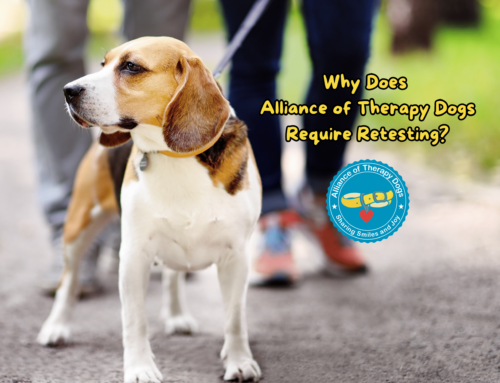As a result of the pandemic, natural disasters, and social anxiety, the importance of having a friend to lean on has never been so important. However, many fail to realize that friendships don’t always have to be between people. Thus, most students miss out on the benefits of having a therapy pet in their lives.
But how exactly do dogs aid in reducing anxiety and improving your overall health? If you want to know, keep on reading!
What are Therapy Dogs?
Certified therapy dogs volunteer alongside their owners in schools, clinics, and care facilities. From accompanying students to visiting a senior living facility, therapy dogs and their owners work collaboratively to better the lives of others.
Therapy dogs vs. Service Dogs: What’s the difference?
The terms “therapy animal” and “service animal” are often used interchangeably, although completely inaccurate. A service dog is a canine companion that has been trained to assist individuals with difficulties in their daily tasks. (animal-assisted therapy) Their common tasks include guiding the blind, notifying the deaf, pulling a wheelchair, and protecting patients suffering seizures.
On the other hand, therapy dogs don’t have the same level of training as service dogs. Nevertheless, they can help alleviate stress and mental pressure. On top of that, they have pleasant personalities and are easygoing.
While service dogs are not allowed to interact or be touched by anyone other than their owner, patients are encouraged to do so with therapy dogs.
What do Therapy Dogs do?
Due to their sensitivity to human emotion, dogs make excellent therapy animals. They have repeatedly demonstrated sympathy and empathy by nuzzling or moaning when they detect a human being is unhappy or in general emotional pain. Therapy dogs’ purpose is to bring comfort and company to any individual.
They are an added benefit in the rehabilitation and stress management processes due to their caring and compassionate nature. Therapy dogs frequently visit locations with vulnerable populations, such as nursing homes, hospitals, and college campuses, providing anxious patients and students comfort.
Unsurprising, therapy dogs are being introduced into business settings to help employees feel less stressed and more productive. Hence, their responsibilities range from actively participating in physical rehabilitation to building children’s and people’s confidence with mental or learning difficulties.
How Do Therapy Dogs Reduce Stress and Anxiety?
Most dog owners consider the connection with their dogs unconditional and dependable. Therapy dogs take that connection one step further. Those suffering from depression, stress, anxiety, and loneliness may find it difficult to open up, yet the presence of a therapy dog gives unlimited emotional support. Dogs won’t judge or condemn those they visit, and they provide smiles and a sense of security.
On top of that, petting a dog helps relieve stress and gives emotional support. The repetitive action produces oxytocin, a stress-relieving hormone that helps battle physical discomfort caused by melancholy, stress, or worry.
Benefits of Therapy Dogs in University
Therapy dogs have been shown to have several advantages in studies conducted in universities, including the following:
- The rise in the number of students attending classes.
- Learning outcomes such as increased reading and writing skills and greater motivation.
- Improved connections with peers and instructors due to experiencing trust and unconditional love.
- Improved communication skills.
Nonetheless, many universities opt out of therapy dog programs due to perceived threats. Concerns about hygiene and the suitability of a dog’s disposition for interacting with young adults are only two of the barriers.
Benefits of Therapy Dogs to Students
Therapy dogs are an excellent resource for calming and welcoming students. Sometimes the dog can feel who is in need and approach a particular student. The students will calm down, pat the dog, and resume their day. A small interaction can have a large impact on someone’s day.
This is a safe method for many students to be welcomed and relax into an otherwise anxious school day. Therapy dogs are often invited during finals week to allow students to break from their studies.
Other benefits include:
- Reduced anxiety and depression.
- Stress hormone reduction.
- Improved social skills.
- Normalized blood pressure and heart rate.
- Gain confidence.
- Improved motivation.
- Positive attitude towards learning.
Making Your Dog a Therapy Dog
Therapy dogs are everyday pets. They do not need extensive training, although obedience training, whether in a class or at home, is very good for reinforcing the bond and communication between you and your pet. Therapy dogs must be well-mannered. No jumping or barking here! Most importantly, you and your dog need to have a bond that demonstrates not owner and pet but partners. For all the requirements to become certified with The Alliance of Therapy Dogs, go to www.therapydogs.com
Basic Requirements for Therapy Dog
- Therapy dogs must be well-tempered.
- Therapy dogs must be outgoing and friendly.
- Therapy dogs must be adaptable to a variety of settings.
Value of Therapy Dogs
Simply having a therapy dog visit may help people forget their troubles, bodily or mental discomfort, and fears or maybe bring a smile. People’s mental and physical health has improved just by touching a dog. So when humans and animals interact, chemicals like serotonin, prolactin, and oxytocin are produced in the brain that plays a role in raising emotions.
Aside from helping people relax and enjoy the company of their animal therapy companion, it also gives comfort, decreases loneliness, stimulates the mind, and serves as a delightful diversion.
Final Verdict: Do You Need a Therapy Dog in Your Life?
Students may benefit from stress-relief programs, but adding therapy dogs may improve such initiatives even more. Even though therapy dogs can’t teach you the technicalities of learning, they can help you cope with your anxiety, improving your chances of academic achievement in the long run.
Indeed, many advantages of having therapy dogs in schools are undeniable, and ideally, this practice should be adopted even more.






